When it comes to the world of business, pricing can be one of the biggest hurdles to overcome. Are you setting them too high and pricing yourself out of the market? Are you lowballing yourself and not getting the sales you desperately desire? There are a plethora of questions you’ll likely be asking yourself.
SaaS businesses in particular have it even worse. With so many different SaaS pricing models you can use and the fact that you’re selling a subscription-based service, the possibilities are endless. And knowing whether you’ve gone down the right path becomes even more difficult. You’re certainly not alone here. Many budding SaaS businesses have faced the same struggles that you have, and even the most successful SaaS companies know that their pricing strategies play a huge role in their success.
|
SaaS Pricing |
Traditional Product Pricing |
|
Value is spread out over a longer period due to the subscription model |
Typically one-off purchases |
|
Many different models for pricing |
Far less to consider when pricing |
Why is SaaS Pricing So Important?
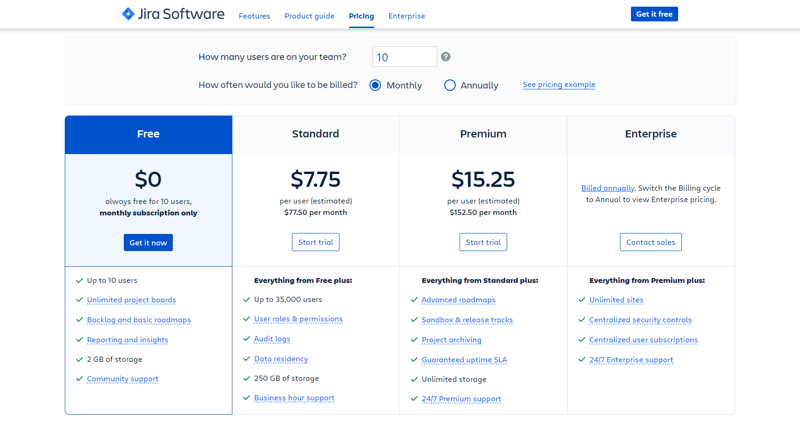
Far too often, SaaS companies will invest a wealth of time into creating a service that ticks all the boxes. It solves a problem for its target audience, sets itself apart from competitors, is user-friendly, etc.
From there, they spend minimal time creating a pricing strategy and dive straight into marketing their service. Even with a well-optimized saas marketing strategy using the best inbound methods, the business fails because it didn’t spend enough time coming up with a proper pricing model and pricing strategy.
It must align with the value and expectations of your audience, and fit your own SaaS business needs.
So what does this mean for you?
Well, you’ll need to understand that pricing isn’t about setting it and forgetting it. Your SaaS pricing is something you’ll certainly need to revisit a few times a year to make sure it reflects the value you’re providing.
Your pricing also affects the way that potential customers view your SaaS business. If you’re pricing too high for a similar service to a competitor who is charging less, that isn’t going to reflect very well on you. If you charge too low, it could be detrimental to the perceived value of your service.
In this post, we’ll cover everything you need to know about developing the right SaaS pricing for your business, including popular pricing models, effective strategies, PowerPoint templates to get you started, and even examples from successful SaaS companies.
SaaS Pricing Models
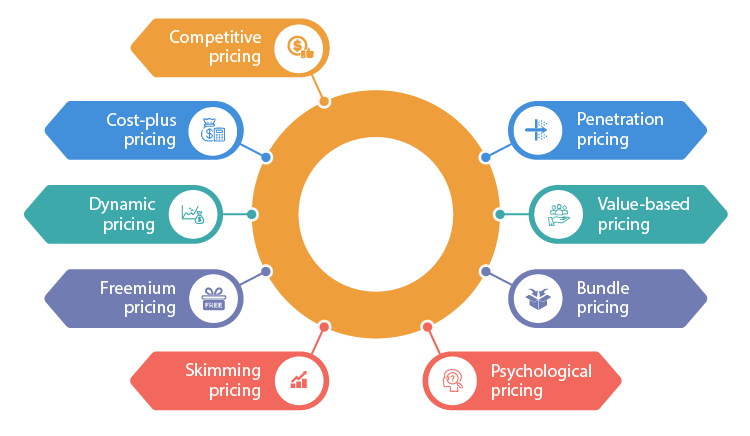
Now that you know the importance of an effective SaaS pricing model, which model should you go with?
This will depend on several factors such as the type of service you’re offering, B2C or B2B, your target audience, the average amount of users per sale, market positioning, and more. You’ll need to figure out which best fits the needs of your customers and your business, which is no easy challenge.
To get you started, here are some of the most popular pricing models used in the current SaaS landscape.
Flat Rate Pricing
The flat pricing model is one of the simplest ways to sell your service. One price, one tier, one service. Complexity is removed to benefit you and the customer alike.
What are the advantages of a flat pricing model?
- Simple for customers to understand
- Predicting different metrics such as churn and revenue growth is far easier with only one plan
- Cuts down the decision time for customers interested in subscribing to your service
- Works well for businesses that have one single product or service and only one primary customer persona
A prime example of flat-rate pricing being used to great effect is Basecamp. Not only do they use the flat-rate pricing model, but they also incorporate it as part of their marketing strategy. Their unique selling point is all about simplicity, and since they’re selling one service at $299 a month, billed annually, it doesn’t get much simpler than that.
They do, however, offer a 30-day free trial before the paid subscription starts. A common tactic used by flat-rate pricing users.

The flat-rate pricing model does come with its fair share of disadvantages. If customers perceive your service to be too expensive for what it provides, there isn’t any wiggle room. Your service may have some features that a large portion of your customers don’t need, and forcing them to pay for the full package could impact the value of your service in a negative way.. You’ve only got one shot to land the customer instead of the multiple shots you’d have when using a tiered pricing model.
Flat-rate pricing can also cripple your own revenue. With upselling being a commonly used tactic to boost revenue, having higher-tier plans can be very attractive. With only one plan to choose from, you eliminate the ability to upsell.
Flat-rate can be an effective SaaS pricing model in certain situations. Just make sure you understand what you’ll be missing out on if you only have one plan.
Per-User Pricing Model
Another simplistic SaaS pricing model, per-user pricing, is fairly self-explanatory. The price is dependent on how many people are using the product within the business. This is a far more common pricing model than the flat-rate model, but what advantages does it bring?
- Simple to understand how much companies will pay for the service
- Scalable, as companies grow and more individuals adopt the product, revenue will follow
- Fantastic for B2B SaaS companies who are targeting growing companies
Slack has had great success using the per-user pricing model. However, they do combine per-user pricing with tiered pricing. Something to keep in mind moving forward.
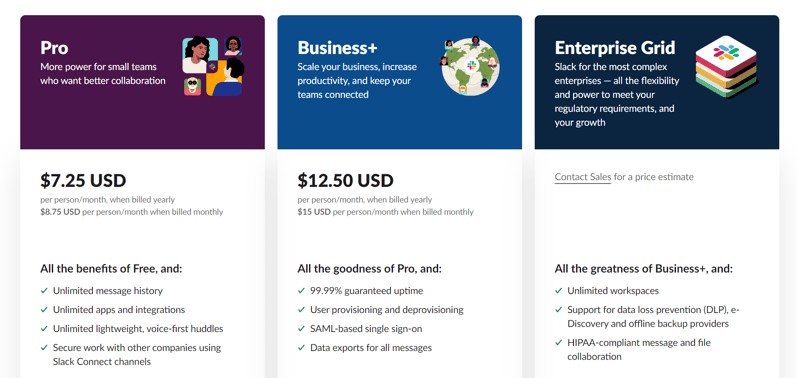
While Slack has achieved success with this pricing model, there can be some glaring problems with it as well. Some of these disadvantages include:
- It limits adoption. If companies know that they’re going to be penalized for having more people using your service, chances are they’ll try to keep their number of users as low as possible.
- Limited adoption can lead to login abuse, meaning several different people all using the same login to keep costs down.
- Lower adoption rates often lead to higher churn rates as well, since a few people using a service are far more likely to churn than an entire company.
Per-user is a far more popular SaaS pricing model, but that doesn’t mean it’s right for you. Take note of the advantages and disadvantages and make the decision for yourself. Don’t just blindly follow the trends.
Tiered Pricing Model
Possibly the most common model used by SaaS companies for their pricing, the tiered pricing model offers some of the best customizability of all the different SaaS pricing models.
At its core, the tiered pricing model is essentially offering multiple different versions, or “tiers”, of your service. These tiers offer more features at each price point. Usually starting with a base-level service, each price point above the base service offers some extra features which would otherwise be locked.
The main upside to using tiers is the wider appeal your service can have to your target audience. If a potential customer isn’t interested in some of the features that your top-tier service provides, they can simply subscribe to your base-level service to suit their needs. Unlike with the flat-rate pricing model, there’s far more wiggle room and potential to sell to customers who may still be on the fence.
Another huge upside of the tiered pricing model is the potential for upselling. In the world of SaaS, upselling your service can become a significant chunk of your revenue. Upselling involves reaching out to users of your lower-tier service and persuading them to upgrade their subscription level. It’s best to reach out to those who are already very pleased with your base service. Attempting to upsell to a customer whose relationship with your company is lacking can cause far more damage.
SalesForce employs the tiered pricing model as part of their pricing strategy:
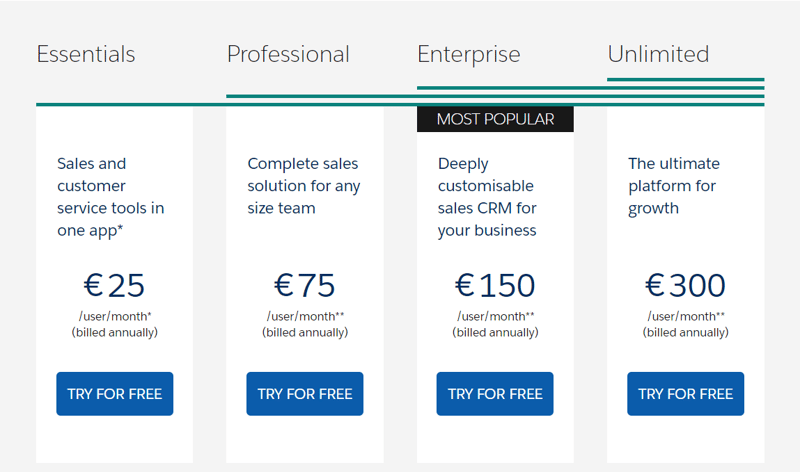
As you can see, their essentials package offers just that: only the essentials. Each tier builds on the previous one, adding new features as the price climbs.
When using the tiered pricing model, it’s important to make sure your tiers are easy to understand for your potential customers. Otherwise, you’ll leave them confused and unable to make a decision on whether or not to sign on to your service. Creating a well-structured features page similar to the one used by SalesForce would be a great start.
The tiered pricing model is easy to recommend due to the wide appeal and potential for revenue increases through upselling. Just make sure your features are laid out in a cohesive way so your customers aren’t left scratching their heads while staring at your features page.
Usage-Based Pricing Model
The usage-based pricing model is equivalent to the “pay-as-you-go” cell phone plan. You only pay for what you use.
How you track usage will depend on what type of SaaS you’re offering. There are two common methods of charging for usage of your service:
- Charging for storage
- Charging per action (messages sent, keywords tracked, emails delivered, etc.)
This model can be great for customers and SaaS businesses alike. For those who need your service, but won’t be using it all the time, they’ll only be billed for what they’ve used. And for those who use your service daily, far more revenue will be generated.
ConvertKit uses this SaaS pricing strategy with their email marketing platform:
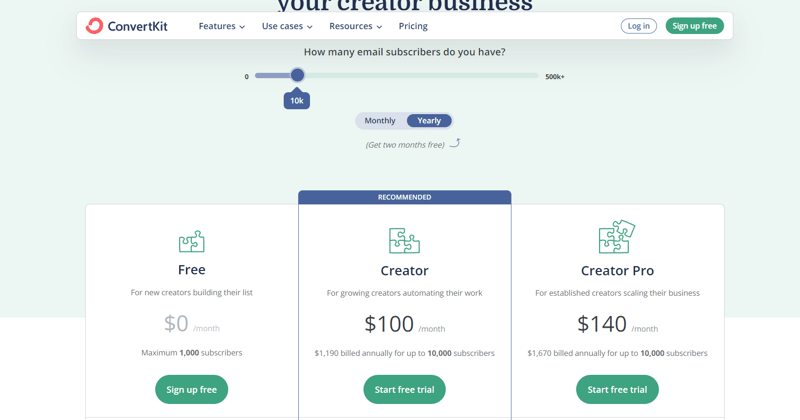
Starting with a 3-month limited free trial, customers are then billed based on how many emails are sent. Hard to say no to a deal like that. They’ve even used the tagline “Pay As You Grow”, which is a nice added touch and describes this plan perfectly.
Of course, the usage-based pricing model has a few disadvantages. First of all, it can be difficult to accurately predict your revenue. There isn’t any real way of knowing how much your customers are going to use your service from month to month.
Customers can fall into the same trap here as well. Many of them won’t be able to predict how much they’ll actually use your service. Meaning they’ll have no idea how much they’re going to spend on it.
Usage-based pricing can certainly benefit some SaaS companies while being a detriment to others. It’ll depend on the service you’re offering.
Per-Active User Pricing
Per-active user pricing is a SaaS pricing model that charges customers based on the number of active users accessing the software. This model is commonly used when the value and usage of the SaaS product are directly tied to the number of users.
Under the per-active user pricing model, customers pay a predetermined fee for each user who actively uses the SaaS product within a defined period, typically monthly or annually. The pricing tier may vary based on the number of users, offering discounts for higher volumes.
Here is an example of a pricing structure for a project management SaaS tool that charges per-active user:
- Basic Plan: $10/user/month for up to 10 active users
- Pro Plan: $8/user/month for 11-50 active users
- Enterprise Plan: $6/user/month for 51+ active users
In this example, customers pay a fixed amount per user, with different pricing tiers based on the number of active users.
Per Feature Pricing
The per-feature pricing is a type of SaaS pricing strategy that bills customers according to the specific features or functionalities they require. This model allows customers to tailor their subscriptions based on their needs and budget.
SaaS providers offer various packages or tiers with different features under per-feature pricing. Customers can choose the package that aligns with their requirements and only pay for the needed features. Pricing plans often have tiered structures, whereas higher-tier packages offer more advanced features at a higher cost.
Consider a customer relationship management (CRM) SaaS platform with per-feature pricing. The pricing plans could be as follows:
- Basic Plan: $20/month includes contact management and basic reporting
- Standard Plan: $40/month includes basic features plus email marketing and sales pipeline management
- Pro Plan: $60/month includes all features plus advanced analytics and integrations
Here, customers can select the pricing plan that best matches their feature requirements and budget.
Freemium Pricing
Freemium pricing is a popular SaaS pricing model that offers a free basic version of the software, with the option to upgrade to a paid version with additional features and functionality. This model aims to attract a large user base by providing value upfront while monetizing advanced features.
SaaS providers implementing the freemium pricing model offer a limited version of their product for free. This allows potential customers to experience the software's core functionality without cost. Users can upgrade to a paid subscription to access advanced features or unlock additional capabilities.
For instance, an email marketing SaaS platform may adopt a freemium pricing model. The free plan could offer basic email campaign management with a limited number of subscribers and templates. To access advanced features such as automation, A/B testing, and analytics, users would need to upgrade to a paid plan, which could be priced at $30/month.
By offering a free version with valuable features, the SaaS provider can attract a larger user base and convert some users into paying customers.
SaaS Pricing Strategies
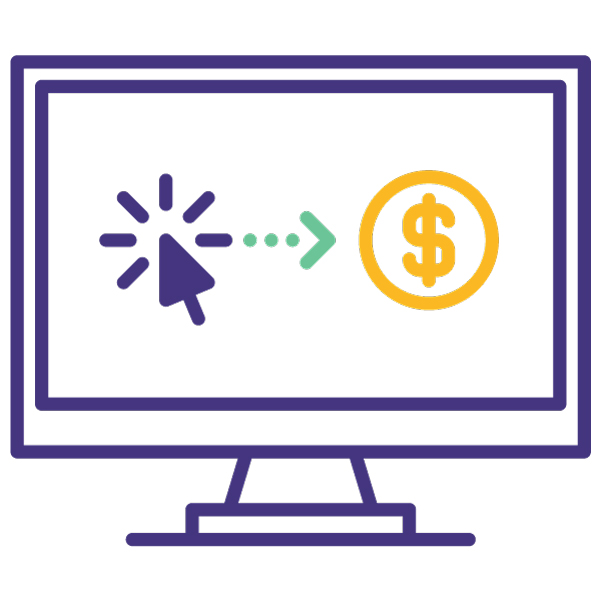
Aside from choosing a SaaS pricing model that best suits your needs, there are also some strategies you can employ once you’ve nailed down the model you’ll be using. These strategies can help give you an edge over your competition. And in a market as competitive as SaaS, you’ll want any edge on your competition that you can get.
Cost Plus Pricing
This is an incredibly basic SaaS pricing strategy, but that’s part of the appeal. Cost plus pricing is often used as a starting point for new SaaS businesses.
All you’ll need to employ this strategy is to figure out the overall costs involved with maintaining your SaaS and coming up with a profit margin that you’re comfortable with. From there, you set your price. So if you want your profit margin to be 20%, you set your prices 20% higher than your costs. This can be used regardless of the pricing model in play.
While simplicity certainly plays an important role here, cost plus pricing ignores many different pricing factors, such as perceived value and competitor pricing. However, since prices shouldn’t be set and forgotten about, cost plus can be a great place to start and get the ball rolling.
Skimming
The skimming pricing strategy can be a great way to jump on initial revenue from a smaller target market before capturing a larger portion of the market. Skimming is the process of setting your SaaS prices higher than normal, before lowering them gradually over time and widening your appeal.
Skimming pricing operates on the premise that demand for your service will deteriorate over time, however. That means this strategy would be best employed when newer releases of your service are planned for the future. You can repeat the skimming strategy with each new release, again capturing higher revenue from a smaller demographic before opening the floodgates to the rest of your audience.
Free Trials
It’s no secret that free trials are a significant part of many SaaS pricing strategies, and it’s easy to see why. They take away much of the risk from the customer and allow them to test your service, worry-free. This can be a great starting point for them to become paying customers.
When using free trials as part of your SaaS pricing strategy, there are a few key considerations you’ll need to keep in mind. You don’t want to offer your free trial for too long. Typically, customers will be quick to make up their minds about whether or not your service is right for them.
You can also consider limiting your free trial by usage. For example, if your service involves an online business chat of sorts, maybe limiting the free version to 1000 total messages before an upgrade is required would work. There are several possibilities here. Just make sure to limit your trials to get your customers to make a decision quicker and weed out the people that you know aren’t going to subscribe.
Penetration Pricing
If you’re looking to beat your competitors to your target market, then penetration pricing could be worth considering.
Penetration pricing is sort of the opposite of skimming pricing. You set your initial prices low in order to appeal to a wider market, and in turn, steal a large share of the market right from under your competitors.
Obviously, this means your pricing may be unsustainable. You’ll need to upsell your customers onto a higher value tier of your service to compensate for the initial lost revenue.
Penetration pricing can be a bit of a risk. Your profit margins will be very low to start. However, if you’re able to capture a larger part of the market and upsell them down the road, the end will certainly justify the means.
Tips for Optimizing a SaaS Pricing Page
As a SaaS company, your pricing page is crucial in converting potential customers into paying users. Here are some tips to help you optimize your SaaS pricing page:
1. Show the Price
Avoid hiding the pricing information or requiring visitors to contact your sales team for pricing details. Transparency is key to building trust and making it easy for potential customers to understand the value they will receive for their investment. Displaying the price prominently helps visitors quickly assess if your product fits their budget and prevents wasting time for both parties if the price is not a good fit.
Look at how Slack displays its pricing options directly on its pricing page. They clearly mention the price for each plan, allowing visitors to evaluate their options without any ambiguity quickly.

2. Use Tables and Bullets to List Tiers and Features
Organizing your pricing tiers and features in a visually appealing manner can greatly enhance the user experience on your pricing page. Use tables or bullet points to outline the different plan options and the specific features of each tier.
This format lets visitors easily compare the offerings and determine which plan best suits their needs. Ensure you highlight each tier's unique features or benefits to help customers understand the value they will receive at different price points.
HubSpot's pricing page effectively uses tables to showcase their different plans and the features included in each. The clear and concise presentation helps visitors quickly grasp the differences between the plans.
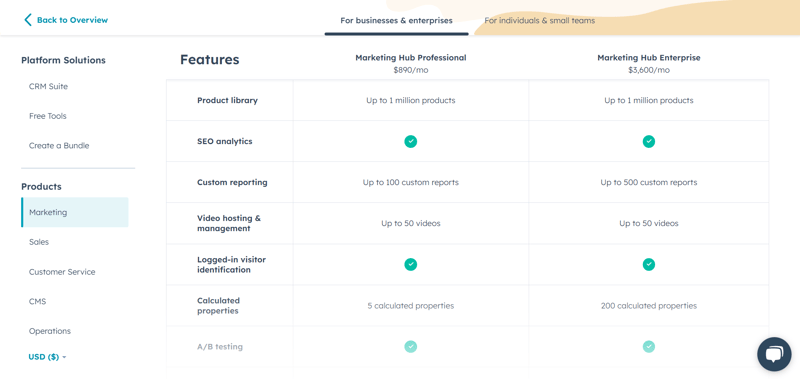
3. Offer Discounts Upfront
Providing upfront discounts can be an effective strategy to incentivize customers to commit to a longer-term subscription. Many SaaS companies offer a discount for annual subscriptions compared to monthly plans. Clearly communicate the savings customers can enjoy by opting for an annual commitment. This approach encourages customers to make a longer commitment and increases your revenue predictability and customer retention.
Microsoft 365 offers a significant discount for annual subscriptions compared to monthly ones. They prominently display the savings customers can enjoy by choosing an annual plan, making it a compelling option for cost-conscious users.
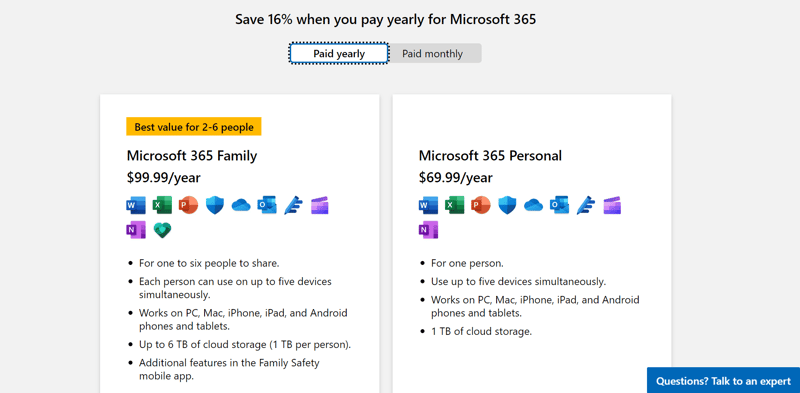
4. Highlight the Most Popular Plan
Highlighting a "Most Popular" plan can guide potential customers toward the option your existing users most commonly choose. This plan is typically positioned as a balanced choice, offering a good combination of features and value. By emphasizing the popularity of this plan, you create a sense of social proof and influence visitors to consider it a reliable and trustworthy choice.
Zoho CRM effectively highlights its "Most Popular" plan on its pricing page. By using eye-catching visuals and labeling it as the most popular choice, they encourage visitors to explore this option further.
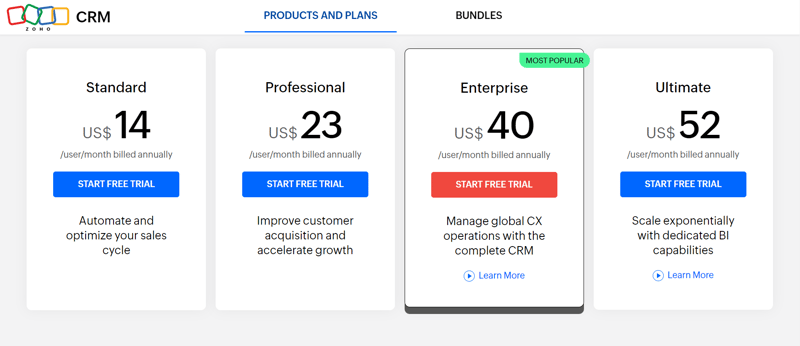
5. Show the Most Expensive Plan First
While it may seem counterintuitive, presenting the most expensive plan first can positively influence customers' perception of value. This technique, known as anchoring, sets a reference point for the pricing tiers that follow.
By starting with a higher-priced option, the subsequent tiers appear more affordable in comparison, even if they are still relatively expensive. This approach can nudge customers towards selecting a higher-tier plan, increasing their perceived value and your revenue.
6. Add Social Proof
Social proof can be customer testimonials, reviews, case studies, or logos of well-known companies that use your product. By showcasing positive experiences from satisfied customers or highlighting reputable brands associated with your product, you build trust and credibility, making visitors more likely to convert.
Slack incorporates social proof on its pricing page by displaying customer stories from companies like Airbnb and Shopify. These testimonials validate the quality and reliability of the product, influencing potential customers' perceptions and decision-making.
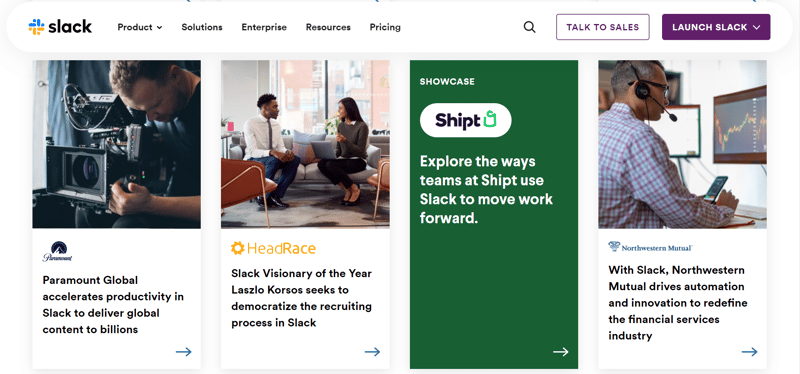
Remember, optimizing your SaaS pricing page is an ongoing process. Continuously monitor and test different strategies to determine what works best for your target audience.
3 SaaS Pricing Page Examples
Now that you know what elements to consider while optimizing your pricing page, let's look at some great examples from other SaaS companies.
1. Dropbox
Dropbox, a cloud storage and file-sharing platform, uses a tiered pricing model on its pricing page. They offer different plans based on storage capacity, with additional features and functionalities available at higher price points. Dropbox effectively presents the pricing options with visually appealing graphics and concise descriptions.
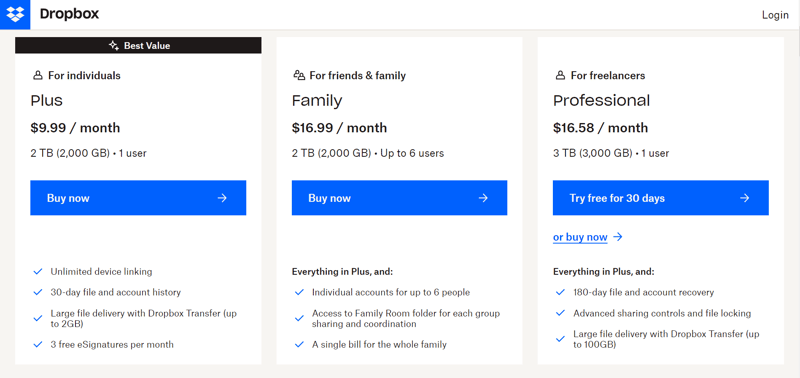
2. HubSpot
On its pricing page, HubSpot utilizes a pricing strategy based on the value of its product, being a top provider of inbound marketing and sales software. They showcase different pricing plans based on the size and requirements of the customer's business. HubSpot emphasizes its software's value and benefits, rather than just listing features.
They also offer a free CRM option, allowing users to experience their product before committing to a paid plan.

3. Zendesk
The pricing page of Zendesk, which is a platform for customer service and support, emphasizes tailored pricing for different customers. They offer different pricing options for startups, mid-sized businesses, and enterprises, catering to the specific needs of each segment. Zendesk provides a comprehensive overview of the features available in each plan and encourages users to contact their sales team for personalized pricing and demo requests.
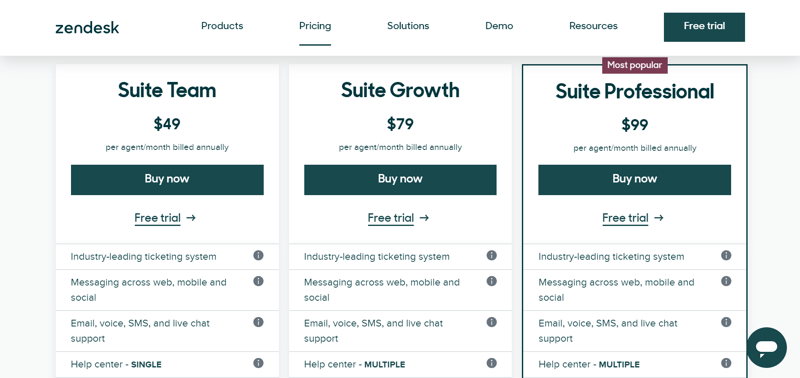
SaaS Pricing Page Template
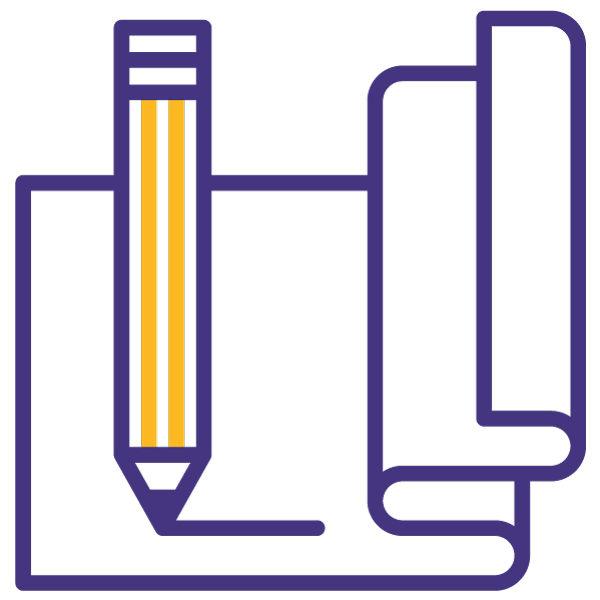
Now that you’ve got a SaaS pricing model in mind and you’re familiar with some of the top strategies, it’s time to build your SaaS pricing page.
Similar to any SaaS landing page, you’ll have to answer a few key questions in order to properly put your SaaS pricing page together. Questions such as:
- Who is your target audience?
- What is your unique value proposition?
- What are your different customer groups willing to pay?
Using that info, you can put together an effective SaaS pricing page based on the pricing model you’re using.
Here’s a simple template to help you get the ball rolling with the tiered pricing model:
|
Customer Demographic #1 (Freelancer) |
Customer Demographic #2 (Small Business) |
Customer Demographic #3 (Enterprise) |
|
Tagline |
Tagline |
Tagline |
|
$/month |
$/month |
$/month |
|
Main Value Feature |
Main Value Feature |
Main Value Feature |
|
Secondary Value Feature |
Secondary Value Feature |
Secondary Value Feature |
|
Secondary Value Feature |
Secondary Value Feature |
Secondary Value Feature |
|
Call To Action |
Call To Action |
Call To Action |
In this template, the different demographics align with the size of the interested business. Perhaps the lowest tier would be best suited to a freelancer or sole proprietor, while the highest tier might be best for a large enterprise. Your taglines should reflect this and align each tier's unique value proposition with that specific demographic.
A flat pricing model template would be more simple and look something like this:
|
Headline |
|
Tagline |
|
Main Value Feature |
|
Secondary Value Feature |
|
Secondary Value Feature |
|
Call to Action |
While these are only templates and don’t need to be followed precisely, they’re great starting points to create an effective SaaS pricing page. Just keep in mind that without a defined target audience and UVP, you won’t get very far.
SaaS Pricing Summary
Figuring out your SaaS pricing strategy when you’re just starting out can seem like an insurmountable challenge. With several different models to choose from and new strategies developing year after year, it’s hard to know if you’ve chosen the right path. Since pricing is such a critical component of SaaS development, it can certainly be anxiety-inducing.
What you need to remember is that your prices aren’t set in stone forever. If your generated leads are turned off by your pricing, it’s time to review them and employ a new strategy or switch up your pricing model. A willingness to adapt is just as important as nailing down the right pricing model for your business.
Still Having Trouble With Your SaaS Pricing?
Sometimes, knowing the different pricing models and strategies at your disposal isn’t enough. If you’re still stressed about setting your prices, why not reach out to us? We’d love to help you out!

Ulf Lonegren
Ulf Lonegren is CEO and Co-Founder of Roketto, where he has led digital marketing strategy for over 15 years. With extensive experience in both traditional SEO and emerging AI search optimization, Ulf has guided hundreds of SaaS and ecommerce companies through major search algorithm updates and platform shifts. His expertise spans from the early days of Google's algorithm changes through the current AI revolution, giving him unique insight into what actually drives sustainable search visibility. Ulf's approach focuses on fundamental optimization principles that adapt to new technologies rather than chasing trending acronyms, a philosophy that has helped Roketto's clients achieve measurable growth across multiple search paradigm shifts.












2.png)
2.png)









